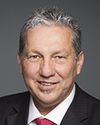Thank you very much, Madam Chair.
Thank you all for allowing me the opportunity to be here today.
Madam Chair, I am pleased to appear before this committee today.
I would like to begin by commending the members of this committee on having embarked on a study on women and girls in sport. As a Paralympian, an experienced administrator in Canada's sport system and the mother of two girls, I believe this is an issue that is more than worthy of study and of our government's full attention.
As someone who was working for former MP Dennis Mills when he was preparing his report almost 20 years ago, I can tell you how far we have come. I have seen a great deal of progress over the last two decades. I have lived it.
I'd like to share my views of the progress we have achieved, as well as my observations on the gender inequities that remain and that keep our women and girls from succeeding.
Canadian women and girls are excelling in high-performance sport like never before. Successful athletes, such as Penny Oleksiak, Brooke Henderson and Aurélie Rivard, inspire pride in all Canadians.
More than this, their example shows us what women can do. Because of women athletes like them, young women and girls across the country can see themselves excelling in sport. For many, this may be just the encouragement they need to take a chance and get involved in sport.
At the Rio Olympic Games, this summer, an impressive 16 of the 22 medals awarded to Canada were won by women. And, at the Rio Paralympic Games, 11 of the 29 medals for Canada were earned by women athletes.
These achievements were watched by the world and will have untold ripple effects throughout the world of sport and beyond. When women succeed in any sector where they are under-represented, their success helps break down the barriers that keep others out.
This is also reflected in the leadership ranks of the Canadian sport system, where more and more women are taking on decision-making roles. They include Canadian Olympic Committee president Tricia Smith; and the CEOs of the Canadian Paralympic Committee, the Coaching Association of Canada, the Canadian Association for the Advancement of Women and Sport and Physical Activity, Canada Basketball, and Tennis Canada. I believe you've already met some of these women in the course of this study.
The achievements of our female athletes and sport leaders are indicative of how far we've come. Decades ago, the challenges were about access—simply getting in the door. Now it's a question of reaching our full potential for the benefit of sport and of society. As part of this evolution, our policy on women and girls in sport was updated to foster sport environments at all levels that encourage and support the participation of women and girls as athletes, coaches, technical leaders and officials, and governance leaders, because an inclusive sport system is the reflection of an inclusive society. A society that fosters the full participation of all women and girls fosters the participation of people with disabilities, members of visible-minority groups, and indigenous people.
Yet, despite the considerable progress that has been made in recent years, gender inequality persists, and traditionally under-represented groups remain on the sidelines. Canadian women and girls across all demographics participate in sport at lower rates than men and boys, and while many teenagers drop out of sport, the rate is particularly concerning for girls. We know that messages conveyed by the media about women, femininity, and sport present a major challenge to keeping girls involved in sport. We need to think about how we can change this.
It's not just girls who miss out when they drop out of sport; it's all of society. We need to stop thinking about this as just a girls' problem or a sport problem. In fact, it's a manifestation of the larger inequalities that persist in society. That's why we as a society need to tackle this issue together.
Here is what we know.
While there is a relatively strong focus on our female medallists at the Olympic and Paralympic games, there is little coverage of women and girls in sport the rest of the time.
For example, in 2014, only 4% of sports programming on Canada's national sports networks featured women's events.
In addition, during the coverage of Rio 2016 events, we saw examples of sports media reporting on female athletes in a way that reinforced stereotypes and outdated gender roles instead of prioritizing athletic achievement. This is just one example of the gender bias and inequity that still exist in organized sport.
And it is a reflection of persistent attitudes in society—a society in which a gender wage gap of close to 20% continues to exist and women continue to shoulder the bulk of unpaid domestic tasks. All of this makes it more difficult for women to take on volunteer and high-profile leadership roles.
We see this clearly in international sport federations. Women account for fewer than 6% of international federation presidents, 12% of vice presidents and 13% of executive committee members.
In short, women and girls continue to face barriers to full participation and representation in the Canadian sport system at all levels and in all capacities. We need to change this.
Through Sport Canada, the Government of Canada, in co-operation with provincial and territorial governments, is taking steps to address these issues. Only national organizations that demonstrate that their programs benefit both men and women are eligible for federal funding. About half of our recipients in the athlete assistance program are women. A main objective of our bilateral agreements with provinces and territories regarding sport participation is to provide opportunities for persons from under-represented groups and our marginalized populations to actively participate in sport as athletes, coaches, officials, and volunteer leaders.
We know, however, that we still have a lot to do and we must take action. All of us together—women, men, sport organizations, and governments—promoting gender equality and inclusion in sport will benefit countless women and girls of all backgrounds and abilities and, in turn, society as a whole. Sport helps to create social cohesion and to build more inclusive communities.
To capitalize on this, we need to encourage participation in sport and also in coaching and sport administration by traditionally under-represented groups. These include women and girls, as well as people with disabilities and indigenous people.
As Minister of Sport and Persons with Disabilities, I am committed to ensuring that all Canadians benefit from sport, and I am determined to close the gender gap in sport participation and leadership for women of all backgrounds and abilities. I anxiously await the recommendations of your study to do even more to encourage the full participation of women and girls in sport and in the Canadian sport system.
I'd now be happy to answer any questions you might have.





